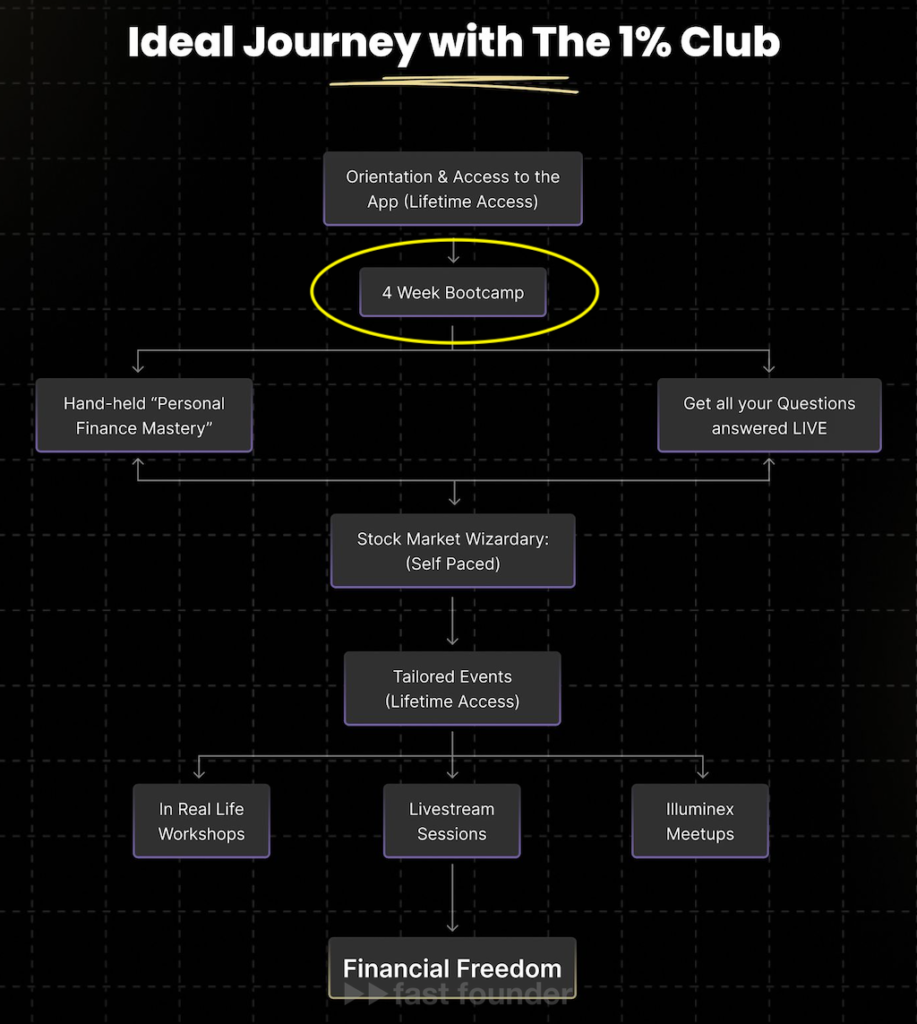A recent trend that’s gaining momentum is the repackaging of educational courses into communities. However, such repackaging cannot be done bluntly. Taking this startup as an example, one can note several important details that will help make such repackaging maximally beneficial for the creators of the community and attractive for its members. Here are the essentials of these details.
The essence of the project

The goal of The 1% Club is to help people achieve a state of financial independence. The “1%” in the name of the service refers to the founders’ belief that less than 1% of the Earth’s population can achieve financial independence.

One of the reasons for this is that most people do not have simultaneous access to everything necessary for this. Everything needed can roughly be divided into three broad areas – a) basic knowledge in the field of finance, b) practical experience in applying this knowledge, and c) direct communication with people who have succeeded and those who aspire to it, in order to constantly fuel their own motivation.

All this in one bottle is what The 1% Club offers to the members of its community. In the community, there is an opportunity to:
- Gain new knowledge at the ‘Financial Freedom University’,
- Apply this knowledge using financial management tools provided by the community creators,
- Meet and communicate with other community members (who want to achieve the same goal) and invited experts (who have already achieved this goal).

Behind the loud name ‘Financial Freedom University’ are actually two training courses launched by the community founders. One is about personal finances, and the other is about investing in stocks. The founders claim that the set of courses will expand over time, and their content will be regularly updated.

The set of financial management tools is quite standard. These tools help users engage in financial and tax planning, choosing securities for investment, calculating the effectiveness of loans they plan to take, comparing the purchase and rental of real estate, and even drafting wills.”

Every week, the community hosts live webinars in the form of presentations, roundtable discussions, or lectures conducted by the community founders or invited experts.

Recently, the community has begun organizing offline events in different cities. These also come in various formats – lectures, workshops, or networking events for community members to meet and interact.

Community members can subscribe to a weekly newsletter and daily financial-themed comics delivered via WhatsApp.

The 1% Club originates from India and targets the Indian audience. Founded last year, it has already attracted over 30,000 members from more than 100 cities across India.
The startup has recently raised its first funding of 100 million Indian rupees (approximately 1.2 million US dollars).
What’s interesting
The startup earns revenue from paid community memberships.

However, unlike many other communities, they don’t have a monthly or annual subscription – their members pay just once for a lifetime membership in the community. But how financially sensible is this decision? Conventional wisdom suggests that it’s more profitable to collect money from users multiple times rather than just once.
That would be true if community members stayed for a long time. Unfortunately for the community creators, this is not the case for the majority. The vast majority of users of any B2C subscription service drop out within the first month, and a significantly smaller minority remains for 2-3 years or more.
Therefore, if the community creators set a one-time membership fee equivalent to, say, a couple of years of regular membership, they have the opportunity to earn much more than with regular payments. Considering the huge number of drop-offs in the first months and significant losses within the first year, the average duration of membership in the average community is typically much less than two years.
Moreover, the initial one-time fee is collected on the wave of initial enthusiasm of new members – allowing the founders to ask for more significant sums 😉
Furthermore, today’s community essentially grew from two educational courses. Membership in a community that includes a course can command more money than just for the course itself, because the perceived value is higher 😉. Thus, repackaging courses into a community enables course creators to earn more than by selling just the “bare” courses.

I recently wrote about such an approach in my review of the Sidebar startup, which created a community for individuals looking to grow their careers. However, the foundation of the community is essentially an educational program that members go through. Sidebar raised $13.55 million in its first round of funding.
There are two more interesting details in The 1% Club model.

The first detail is that new club members go through a 4-week intensive (bootcamp). While this is not a mandatory condition, the website states that it is highly desirable and beneficial for club members.
And it’s also beneficial for the community creators 😉. Because such a bootcamp right after registration is a powerful tool for onboarding and activating new community members. During this time, new members can be told and explained what can be done in the community, they can be assisted in mastering new tools and achieving their first results, and, ultimately, a habit of visiting the community app daily can be cultivated.
This bootcamp is likely not conducted individually for each new member, but rather for all members who have joined the community over the last month or week. On one hand, this means that community creators do not need to spend time on each individual. On the other hand, learning something in a group is always more fun, and during the process, new members get to know each other and establish connections, which also serves as an incentive to keep them in the community.

And do you remember about the comic subscription for community members, which can be delivered daily to subscribers via WhatsApp?

The detail is that this subscription is free only for the first year 😉 Starting from the second year, you can stop paying for membership in the community — but if you still want to receive the comics, you will have to pay for the subscription.
Let’s say the subscription costs very little — but it still becomes regular additional money that will accumulate over the entire duration of membership in the community. At the same time, the first free year can cultivate the habit of reading these comics, and therefore many subscribers may want to continue paying for their receipt.
The trick is that the creators of the community can expand the list of chargeable services from the second year by including some useful tools that members of the community have become accustomed to using for free during the first year. This means that over time they can grow the assortment of chargeable tools to such an extent that the remaining loyal users in the community will start paying for these tools, an amount comparable to some regular subscription.
In other words, community creators have the opportunity to essentially double the subscription price unnoticed by users! Because they take the first part once when they join the community. And the second – for the subscription to content and tools. But, starting from the second year, when the pain of the first payment has already been forgotten 😉
Where to run
The first direction of possible movement is the repackaging of existing courses in communities or even the creation of new communities, the basic value of which are educational courses. An important detail — all such courses within the community should be dedicated to achieving some big goal. Which, due to its size, is unattainable 😉
But in a good sense — in that it constantly moves away as a new level is reached. “Financial independence,” as in the case of today’s The 1% Club, begins to mean completely different things at each achieved level of income. “Career growth,” as with Sidebar, also means different things depending on the career position achieved.
Such constant deferral of the goal as intermediate results are achieved is the only way to keep people in the community for a long time. If the goal is achieved — there is no reason to stay in the community. If no results are obtained — the same. And if results are achieved, and the goal is not reached — it means it is possible and necessary to continue.
Well, in addition, when creating such a community, one should not forget about the useful things that we saw at today’s The 1% Club:
- A one-time payment for lifetime membership in the community,
- An intensive program for new community members,
- The start of charging for certain services, beginning from the second year of membership in the community.

It’s worth noting that today’s The 1% Club has emerged at the right time and place—as the Indian middle class is currently growing rapidly. The percentage of Indians belonging to the middle class will double in the next 20 years—from 30% to 61% of the population. By 2030, the middle-class percentage will have risen to 47% of the population.

If we look at the absolute numbers, they are simply staggering. By 2030, 715 million Indians will be classified as middle class, and by 2046, this number will exceed 1 billion.

Moreover, it is the middle class that contributes the most to income, expenditures, and savings of the Indian population. In the years 2020-2021, they already accounted for 50% of the income, 48% of expenditures, and 52% of savings.
One of the important goals of the middle class is to achieve, maintain, and improve financial independence. Moreover, they have the means to pay for the necessary knowledge and tools for this. Thus, The 1% Club has chosen an excellent, growing audience of immense size for itself.
Many of us already belong to the middle class, accustomed to a set of certain services and amenities. And in India, a huge number of people are only now beginning to try them. Therefore, such services are only now starting to appear and develop. Meanwhile, the potential market of 1 billion middle-class people in just one country is a very big and enticing pie.
This leads to the second possible direction of movement—creating services and amenities for the middle class in India, which in more developed countries seem already natural and familiar. There are many such services and amenities. They can simply be taken and copied, with possible adaptation to the Indian specifics. And there is no need to reinvent the wheel 😉
About the company
The 1% Club
Website: onepercentclub.io
Latest round: $1.2M, October 30, 2023
Total investments: $1.2M, rounds: 1
